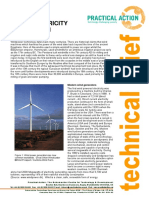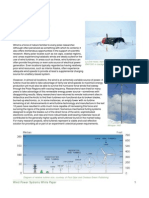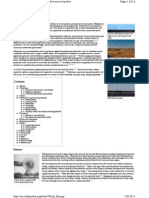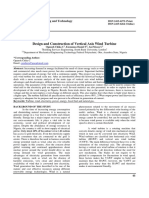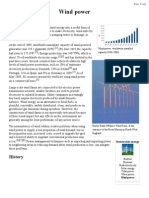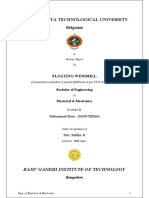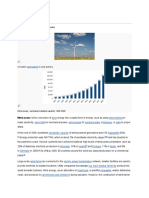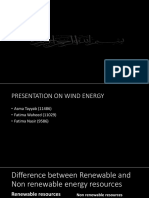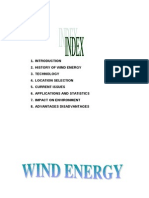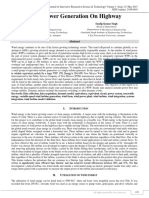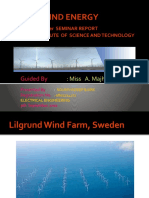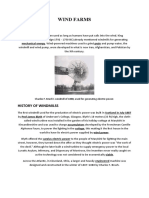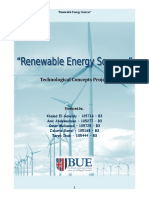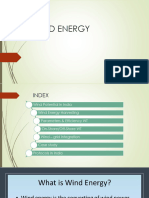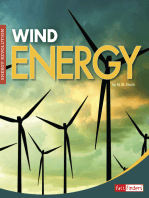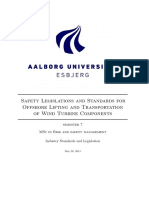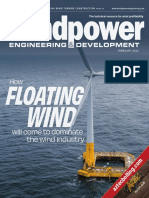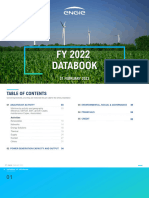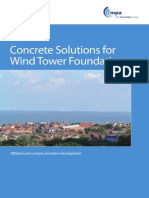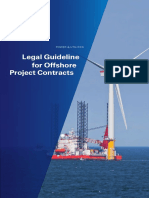Professional Documents
Culture Documents
Framework of Generating Electricity From Wind Energy Source: African Perspectives
Framework of Generating Electricity From Wind Energy Source: African Perspectives
Original Title
Copyright
Available Formats
Share this document
Did you find this document useful?
Is this content inappropriate?
Report this DocumentCopyright:
Available Formats
Framework of Generating Electricity From Wind Energy Source: African Perspectives
Framework of Generating Electricity From Wind Energy Source: African Perspectives
Copyright:
Available Formats
Volume 8, Issue 9, September – 2023 International Journal of Innovative Science and Research Technology
ISSN No:-2456-2165
Framework of Generating Electricity from
Wind Energy Source: African Perspectives
Eben A. Nornormey1 Reine Makafui McEben-Nornormey2
Department of Electrical Engineering Department of Mechanical Engineering,
Accra Institute of Technology, University of Technology and Economics
Accra, Ghana Budapest, Hungary
Nathaniel Awudu Nelson 3, Emmanuel Atta4
Department of Electrical Engineering Department of Electrical Engineering
Accra Institute of Technology Accra, Ghana Accra Institute of Technology Accra, Ghana
Augustine Kweku Mbeah 5 Felix Okpoti6
Department of Marine Electrical Engineering Department of Marine Electrical Engineering
Reginal Maritime University, Nungua, Ghana Reginal Maritime University, Nungua, Ghana
Abstract:- This article is resolved to demonstrate the I. INTRODUCTION
variability of generating electricity from wind energy
from the African settings. This paper brought to the fore Wind energy or wind power is the process of generating
the historical background of wind energy. There are electricity using the wind, or air flows that occur
some concerns when generating electricity from wind naturally in the earth’s atmosphere. Wind is caused by
energy source. This paper disabused some of the the uneven heating of the earth’s surface by the sun.
concerns and projected the advantages and benefits of Since the earth’s surface is made of very different types
generating electricity from wind energy source. The of land and water, it absorbs the sun’s heat at different
paper also discussed the construction of wind power rates. During the day, the air above the land heats up
systems and the components that made up this plants. more quickly than the air over water. The warm air over
Harnessing this energy could be done from wind farms, the land expands and rises, the heavier, cooler air
this write up described the types of wind farms: onshore rushes in to take its place, creating winds. At night, the
and offshore wind farms. The paper revealed the winds are reversed because the air cools more rapidly
characteristics of wind energy that could facilitate the over land than over water. In the same way, the large
generation of electricity from wind source. To prove the atmospheric winds that circle the earth are created
suitability of generating electricity from wind energy, the because the land near the earth's equator is heated more
paper tabulated some of the countries in the world that by the sun than the land near the North and South Poles.
generated significant amount of electricity from this Today, wind energy is mainly used to generate
source. The paper also described in depth the electricity. Wind is called a renewable energy because
perspective of Ghana in the generation of electricity the wind will blow as long as the sun shines. There are
from wind energy. The paper discussed data obtained three main types of wind energy, these are:
from Energy Commission of Ghana and settled on eight
locations or sites for analysis. The mathematical Utility-scale Wind, this is a generation method whereby
expressions and equations that encompassed generation power produced ranges from 100 kilowatts to several
of electricity from wind energy source were deliberated megawatts. Electricity generated by this method is
on extensively in this write up. The article also brought delivered to the power grid and distributed to the end
to the fore the technical and geographical wind user by power distributing companies or power system
potentials of Ghana and modelled mathematically the operators.
available power from the output of wind turbines. The Distributed or "Small" Wind, this generation method
carbon dioxide emission that could be reduced by Ghana consists of a single small wind turbine that can produce
from this research was also discussed. power below 100 kilowatts. Electricity generated from
this technique is not connected to the grid but rather used
Keywords:- Electricity, Wind Energy, Onshore, Offshore, directly to power a home, farm or small business.
Wind Farms, Available Power, Wind Turbines, Carbon Offshore Wind, in this generation technique, wind
Dioxide. turbines are erected in large bodies of water, usually on
the continental shelf. Offshore wind turbines are larger
than land-based turbines and can generate more power
that ranges into several megawatts.
IJISRT23SEP793 www.ijisrt.com 2148
Volume 8, Issue 9, September – 2023 International Journal of Innovative Science and Research Technology
ISSN No:-2456-2165
Wind Energy is the most matured and developed Electricity generated from onshore wind source is
renewable energy; it is free, clean and readily available, inexpensive, in many places it is cheaper than coal or gas
it reduces the emission of greenhouse effect gases and plants. Offshore wind is steadier and stronger than on land
preserves the environment. and offshore farm have less visual impact, but construction
and maintenance costs are considerably higher [2]. Small
The wind turbines have a lifespan of twenty years; they onshore wind farms can feed some energy into the grid or
are often grouped together in to what is known as wind provide electric power to isolated off-grid locations [3].
farms. A wind farm functions as a single power plant and
sends electricity to the grid. Installation of Wind Power II. HISTORY OF WIND POWER
Generation Plants are increasing astronomically; the leading
countries in this regard are China, the United States and It is factual that wind had been used to propel boats for
Germany. The total global installed capacity of wind power many thousands of years (wind energy was used to propel
was over 906,000 MW (906 GW) by the close of 2022 [1]. boats along the Nile River as early as 5,000 BC) before a
Windmills and Wind Turbines are sometimes used wind-driven wheel was used to power a machine in the 1st
interchangeably but there are important differences; century. This machine was invented by a Greek engineer,
windmills are used to generate mechanical energy to grind called Heron of Alexandria. By 7th to 9th century
grain, pump water, and do other works. Wind Turbines windmills were used for practical purposes in the Sistan
generates electricity by using the kinetic energy produced by Region of Iran, near Afghanistan. The Panemone windmills
the effect of air currents. were used to grind corn, flour, and to pump water. Figure 1
shows example of historical windmill.
Fig 1 Historical Windmill
The first known wind turbine used to generate factory in Minneapolis, Minnesota in 1927. Their wind
electricity was invented in 1887 and built in Scotland. The turbines were mainly used on farms. By 1957 the factory
wind turbine was created by Prof James Blyth of Anderson's had sold approximately 30,000 wind turbines including to
College, Glasgow (now known as Strathclyde University). customers in Africa and Antarctica. In 1941 the first
In 1888, inventor Charles Brush created the first known US megawatt-size wind turbine was connected to a local
wind turbine for electricity production. The electricity electrical distribution grid. The 1.25-MW Smith-Putnam
generated was used to power his mansion in Ohio. Poul la wind turbine was erected in Castletown, Vermont; the length
Cour, a Danish scientist, discovered in 1903 wind turbines of its blades was 75feet or 23m [4]. A former student of
with fewer blades that spin faster and more efficient than Poul la Cour, Johannes Juul in 1957 invented horizontal-axis
turbines with many blades that spin slowly. He also started wind turbine with a diameter of 24 meters and 3 blades very
the Society of Wind Electricians; this society held its first similar in design to wind turbines still used today. The wind
course on wind electricity in 1904. 72 electricity-generating turbine has a capacity of 200 kW and it employed a new
wind power systems were running across Denmark by 1908. invention, emergency aerodynamic tip breaks, which is still
Joe Jacobs and Marcellus Jacobs open the “Jacobs Wind” used in wind turbines today.
IJISRT23SEP793 www.ijisrt.com 2149
Volume 8, Issue 9, September – 2023 International Journal of Innovative Science and Research Technology
ISSN No:-2456-2165
In 1975, a NASA wind turbine program to develop electricity generation from wind was nearly 7%. Incentives
utility-scale wind turbines started. This research and in Europe have resulted in a large expansion of wind energy
development program pioneered many of the multi- use there. China is investing heavily in wind energy and
megawatt turbine technologies in use today, including: steel now has the world's largest wind electricity generation
tube towers, variable-speed generators, composite blade capacity [7]. Airborne wind energy systems use airfoils or
materials, partial-span pitch control, as well as aerodynamic, turbines supported in the air by buoyancy or by aerodynamic
structural, and acoustic engineering design capabilities. The lift. The purpose is to eliminate the expense of tower
large wind turbines developed under this effort set several construction, and allow extraction of wind energy from
world records for diameter and power output. In 1975, the steadier, faster, winds higher in the atmosphere. As yet no
first US wind farm was put online, producing enough power grid-scale plants have been constructed. Many design
for up to 4,149 homes. Tvind school teachers and students concepts have been demonstrated.
produced the world’s first multi-megawatt wind turbine in
1978. They had important help from German aeronautics III. CONCERNS OF WIND ENERGY
specialists with the construction of a novel wing. This wind TECHNOLOGY
turbine is still running today.
Even though the unpollutabilty of this technology, the
The world's first wind farm consisting of 20 wind sustainability of the raw material (wind) used and the
turbines was put online in 1980; in the same year Denmark creation of employment that accompanies generation of
started siting offshore wind turbines. By 1990, 46 wind electricity from wind source; there are some concerns. The
farms were online in the US, providing enough power for up major concerns include initial expenditure; the wind turbine
to nearly 300,000 homes. The first offshore wind farm in the plants have a lot of mechanical components that suffer from
world was constructed in southern Denmark in 1991. It was wear and tear, therefore need to be maintained regularly.
made up of 11 wind turbines manufactured by Bonus Another disquiet, is that the wind is intermittent and does
Energy, each with a capacity of 450 kW. In 1991, UK's first not always blow when electricity is needed. Wind energy
onshore wind farm was constructed in Cornwall. The wind cannot be stored (unless batteries are used); and not all
farm was made up of 10 wind turbines, this wind farm winds can be harnessed to meet the timing of electricity
together produced enough electricity for approximately demands. Not all wind can be used to generate electricity,
2,700 homes. The Global wind power capacity reached perfect wind sites, good enough to generate electricity are
6,100 megawatts in 1996. In 2003 UK's first offshore wind often located in remote areas, far from cities where
farm was opened in North Wales. It was made up of 30 wind electricity is most needed. Other concerns are the noise
turbines, each with a power capacity of 2 megawatts. The emanating from the wind turbines which is unfriendly to
first large-capacity floating wind turbine in the world began people staying close to wind farms and the menace that the
operating off the coast of Norway in 2009. It used a Siemens blades of the wind turbines may cause to wildlife (birds and
wind turbine and was developed by Statoil. In 2009 the bats may be killed by the rotating blades).
Roscoe Wind Farm in Texas was opened; it became the
largest wind farm in the world. It has a power capacity of IV. CONSTRUCTION OF WIND POWER
781.5 megawatts and was made up of 634 wind turbines [5]. SYSTEMS
By 2010, 581 wind farms were online in the US, The wind is a by-product of solar energy.
providing enough power for up to 10 million homes. In the Approximately, only 2% (3.6 × 109 MW) of the sun's energy
same year, China passed US to become the country with the reaching the earth is converted into wind energy [8]. Wind
most cumulative installed wind power capacity in the world. energy is the kinetic energy of air in motion, also called
In 2011, Japan announced plans to build multiple-unit wind. The device used to convert the kinetic energy from the
floating wind farm (6 wind turbines, each with 2 megawatts wind is the wind turbine. The wind turbine can convert
of capacity). In 2012, the installed wind power capacity in kinetic energy from the wind into mechanical energy or
China reached 75 gigawatts, the most in the world for a wind power. This device will be known as wind turbine or
single country. UK had the most installed offshore wind wind power plant if the mechanical energy is used to
power capacity in the world; it had over 3 gigawatts of generate electricity. If the mechanical energy is used for
offshore wind power three times more than Denmark, which grinding purposes such as grains or pumping water the
came in second. Wind power constituted over 30% of device will be called windmill. [9]. Therefore, wind turbine
Denmark’s electricity needs. Global wind power capacity is an equipment that is used to capture the kinetic energy in
also reached 282,587 megawatts in 2012. Japan is the first the wind and convert it to mechanical or electrical
country in the world to install hybrid wind/current-powered energy. Wind turbine is sometimes called wind generator.
turbine in 2013; this hybrid was installed off the coast of There are two main classes of wind turbines, these are
Japan. US launched its first offshore wind turbine. Horizontal wind turbine shown in figure 2 and Vertical wind
turbine shown in figure 3. The blades of the horizontal wind
Today, ongoing advancements in wind technology turbine rotate on an axis parallel to the ground whereas
have helped make wind more reliable and efficient than ever those of vertical wind turbine rotate on an axis perpendicular
as a clean power source. By the end of 2015, there were to the ground. The vertical wind turbines are not as common
over 314,000 turbines worldwide generating about 3.7% of as the horizontal wind turbines.
the world’s electricity [6]. In 2018, the share of U.S.
IJISRT23SEP793 www.ijisrt.com 2150
Volume 8, Issue 9, September – 2023 International Journal of Innovative Science and Research Technology
ISSN No:-2456-2165
Fig 2 Horizontal Wind Turbine
Fig 3 Vertical Wind Turbine
The Major Parts of Wind Turbine are:
Foundation (Base), Tower, Nacelle, and the Rotor (with two or three Blades attached to the Hub)
Foundation
The foundation of the wind turbine is very critical, if the base is not well constructed the wind turbine may tumble. The
construction starts by excavating a hole and placing reinforcement such as steel in the hole. Fill the hole with about 325 yard or
303m of concrete; the dimensions of the foundation should be approximately 55 feet or 17m wide and 8 feet or 2.5m deep in the center.
Figure 4 depicts a foundation of wind turbine.
IJISRT23SEP793 www.ijisrt.com 2151
Volume 8, Issue 9, September – 2023 International Journal of Innovative Science and Research Technology
ISSN No:-2456-2165
Fig 4 Foundation
Tower
The tower is the most important part of the wine turbine. The other components that are contained in the wind turbine are
also supported by the tower. It lifts the wind turbine to a height between 40 to 100 meters if the wind turbine will be used for
commercial wind power plants. This height enables the tip of the blades to rotate freely in the sky without any hindrance. It also
helps maintain adequately strong wind. The towers used for wind turbine include: tubular steel tower shown in figure 5, lattice
tower shown in figure 6, Guyed Pole Tower shown in figure 7 and concrete tower shown in figure 8. In large wind turbine energy
plants, tubular steel towers are mostly used.
Fig 5 Tubular Steel Tower
IJISRT23SEP793 www.ijisrt.com 2152
Volume 8, Issue 9, September – 2023 International Journal of Innovative Science and Research Technology
ISSN No:-2456-2165
Fig 6 Lattice Tower
Fig 7 Guyed Pole Tower
Fig 8 Concrete Tower
IJISRT23SEP793 www.ijisrt.com 2153
Volume 8, Issue 9, September – 2023 International Journal of Innovative Science and Research Technology
ISSN No:-2456-2165
Nacelle
The nacelle is a kiosk like object situated on the tower. All the components such as the electrical generator, power converter,
gearbox, turbine controller, cables, and yaw drive of a wind turbine are lodged in the nacelle.
Rotor (with two or three Blades attached to the Hub)
The function of the Rotor is to collect energy from the wind. The rotor of a modern wind turbine is composed of two or
three metal of fiberglass blades. The three blade types are aligned at an angle of 120 degrees between them. The blades are fixed
to the hub; the hub is fixed to the main shaft. The operation of the blades is designed on the principle of either lift or drag. The
characteristic of the lift blades has the same attribute that allows a bird, airplane or kite to fly. The drag blades are characterised by
the wind virtually pushing the blades out of the way. Wind turbines with lift blades have higher rotational speed than those
designed with drag blades. Wind turbines fitted with lift blades are very good for electricity generation. Figures 9 and 10 show the
components of a wind turbine.
Fig 9 Wind Turbine Components
Fig 10 Wind Turbine Components
IJISRT23SEP793 www.ijisrt.com 2154
Volume 8, Issue 9, September – 2023 International Journal of Innovative Science and Research Technology
ISSN No:-2456-2165
The construction of wind turbine comes with a lot of electricity production capacity. These individual wind
parts. A typical wind turbine will contain as many as 8000 turbines are interconnected with a medium voltage of
different components, of which the tower is a very important usually 34.5 kV power collection system and
part since it carries almost all the other components. A well- communications network. The wind farm has a substation
constructed foundation keeps the tower in place. The nacelle where a transformer is used to increase the medium voltage
which is situated on top of the tower can be found behind to a high voltage which can be connected to a high voltage
the blades. The nacelle is the main body of the turbine. The transmission system. A wind farm may contain hundreds of
Anemometer and wind vane are mounted at the back of the individual wind turbines and can expand to hundreds of
nacelle. The rotor carries the blades which are fitted to the square kilometers land surface. The Gansu Wind Farm
hub. The low speed shaft is directly connected to the hub (Jiuquan Wind Power Base) in China is the world largest
and the gearbox. The gearbox is fitted to the generator. The wind farm; it would have when fully completed 7000 wind
yaw motor that is mounted between the nacelle and the turbines. These turbines would have installed capacity of 20
tower is connected to the yaw drive which is linked to the GW [10]. A wind farm as the case may be, will be situated
high speed shaft. The high speed shaft is then connected to at: On-Shore, Off-shore, Near-shore and Air-borne. On-
the brake. shore wind farms are generally located three kilometers or
more into inland from the nearest coastline. The appropriate
Wind Farms areas to locate these farms are open plains, rounded hills top
Wind farm is a cluster of wind turbine plants located at and mountainous regions. Figure 11 shows example of on-
the same place with the aim of aggregating their individual shore wind farm.
Fig 11 On-Shore Wind Farm
Off-shore wind farms are generally situated ten kilometers or more from land. They are more expensive to install than their
counterpart on land. Even though installation of off-shore wind farms have huge cost implication, their advantages cannot be over
emphasized. The wind speeds of offshore are about twenty percent higher than those on-shore. According to the wind power law,
the offshore wind power can capture much more power than the onshore one. This indicates that an offshore wind turbine may
gain a higher capacity factor than that of its land-based counterpart. Offshore wind speeds are relatively uniform and have lower
resistance than on-shore wind speeds; due to these attributes, there is reduction in wears and tears of offshore blades and turbines.
Figure 12 shows example of off-shore wind farm.
Fig 12 Off-Shore Wind Farm
IJISRT23SEP793 www.ijisrt.com 2155
Volume 8, Issue 9, September – 2023 International Journal of Innovative Science and Research Technology
ISSN No:-2456-2165
Near-Shore wind farms are generally located within that get to the blades need to be taken account off, hence
three kilometers from coastline (shoreline) or on water anemometer is put in place to automatically measure the
within ten kilometers from land. These areas are good sites speed of the wind. [13]. Wind vane also measures the
for turbine installation, because wind is produced by direction of the wind. For safety reasons, brakes are
convection due to differential heating of land and sea each connected to the shafts to stop the rotor from rotating in
day. Wind speeds in these zones share the characteristics of windy or turbulent situations. During routine maintenance,
both onshore and offshore wind, depending on the the brakes are also used to stop the rotor from turning. Yaw
prevailing wind direction. Airborne wind turbines would drive and yaw motor are employed to reposition the nacelle
eliminate the cost of towers and might also be flown in high to face the wind when the direction of the wind alters; since
speed winds at high altitude. No such systems are in the nacelle can only extract the full energy from the wind
commercial operation yet. when it faces its direction.
Operation of Wind Turbine Plants Objective
Wind speed is behind the generation of electricity by The aim of this paper is to demonstrate how countries
wind turbine. The relationship between wind speed and in the world over are using the power of the wind to
power is defined by a power curve, which is unique to each generate considerable amount of electricity and the prospect
turbine model and, in some cases, unique to site-specific of African countries to do same.
settings. In general, most wind turbines begin to produce
power at wind speeds of about 4 m/s (9 mph), achieve rated V. METHODOLOGY
power at approximately 13 m/s (29 mph), and stop power
production at 25 m/s (56 mph) [11]. The blades can also turn The methods employed by the researchers in bringing
sideways automatically during high winds to limit speed. to the fore generation of electricity using wind power
include installed wind energy capacity of some countries in
The electricity generation process starts when the wind the world by 2022 and mathematical analysis of wind power
blows the rotor blades of the wind turbine. The rotor traps system.
some of the wind’s kinetic energy. The rotation of the rotor
spins the drive shaft which is connected to it quite slowly. Installed Wind Energy Capacity of Some Countries in
The gearbox that is located inside the nacelle converts the the World by 2022
low-speed rotation of the drive shaft of about 16 rpm into
high speed of approximately 1600 rpm. [12]. The rotation at We selected five countries in each continent with high
this level is high enough to drive the generator effectively. wind energy installed capacity except Africa where all the
The generator converts the kinetic energy (mechanical countries were factored into the studies. The rest of the
energy) coming from the spinning drive shaft into electrical continents are Europe, America and Asia; for the purpose of
energy. Cabling system is used to evacuate the electric this project, Australia was added to Asia. The global non-
current produced by the generator to a nearby step-up renewalable energy consumption and its attendance carbon
transformer. The step-up transformer increases the voltage dioxide emission are increasing sharply putting into focus
from the generator to about fifty times. This voltage is high the importance of wind energy. Table 1 illustrated five
enough to be transmitted onto the power grid efficiently. selected countries and their wind turbine installed capacity
Wind turbine is a complex machine, therefore every wind by 2022.
Table 1 Five Selected Countries and Installed Wind Turbine Capacity by 2022
2022
Gigawatts (GW)= 109 W
ASIA Total
China India Australia Japan South Korea
366 42 10.1 4.6 1.9 424.6
EUROPE
Germany Spain United Kingdom France Sweden
66.3 29.3 28.5 21.1 14.6 159.8
AMERICA
United States Brazil Canada Mexico Argentina
140.9 24.2 15.3 7.3 3.3 191
AFRICA
South Africa Egypt Morocco Other Africa Tunisia
3.1 1.6 1.6 1.2 0.3 7.8
IJISRT23SEP793 www.ijisrt.com 2156
Volume 8, Issue 9, September – 2023 International Journal of Innovative Science and Research Technology
ISSN No:-2456-2165
Installed Wind Energy Capacity of Selected Seventeen African Countries by 2020
Africa has huge potential of generating significant amount of her electricity needs from wind power, however this has not
been realised yet. Even though, some African countries have made giant stride in this sphere, these researchers believe more
could be accomplished. Table 2 spelt out 17 African countries which have at least one megawatt (MW) of installed wind energy
capacity.
Table 2 Seventeen African Countries with Installed Wind Energy Capacity in MW
2020
Megawatts (MW) = 106 W
Africa
1 South Africa 2,465
2 Egypt 1,465
3 Morocco 1,309
4 Kenya 338
5 Ethiopia 325
6 Tunisia 242
7 Mauritania 137
8 Cape Verde 26
9 Libya 20
10 Algeria 11
11 Nigeria 10
12 Mauritius 10
13 Seychelles 6
14 Namibia 5
15 Gambia 1
16 Eritrea 1
17 Chad 1
There are a lot of African countries such as Tanzania and Ghana just to mention a few that have the potential to generate
electricity from wind energy source. These countries especially Ghana lacks progress and to a large extend regressing in the
development of this facility. The Energy Commission of Ghana researched and tabulated wind energy resource locations in the
country. Table 3 illustrates some of the wind energy resource assessment locations in Ghana.
Table 3 Results of Wind Energy Resource Assessment in Some Sites in Ghana
Wind Speed in m/s at 50m Height
Coordinates 5.68⁰N; 5.97⁰N; 5.79⁰N; 5.32⁰N; 5.79⁰N; 5.47⁰N; 5.62⁰N; 5.22⁰N;
(Latitude; Longitude) 0.07⁰E 0.44⁰E 0.52⁰E 0.20⁰E 0.55⁰E 0.55⁰E 0.07⁰E 0.35⁰E
MONTH Kpone Lolonya Pute Aplaku Adafoah Anloga Tema Warabeba
JAN 7.2 7.6 8 6.9 7.6 6.6 6.8 5.8
FEB 8.8 7.8 6.8 7.1 7.7 7.1 6.9 6.6
MAR 7.6 6.7 7.1 7.6 6.9 6.7 6.6 5.2
APR 6.7 6.9 7.6 6.7 6.8 6.9 6.7 4.7
MAY 6.8 7.2 7.8 6.8 7.2 6.7 6.8 5.7
JUN 6.9 6.9 6.9 7 7.3 6.9 5.9 4.9
JUL 7.1 7.8 7.8 7.1 6.8 7.1 7 6.7
AUG 6.9 6.9 7.9 6.9 6.7 6.8 6.9 4.9
SEP 7.6 7.6 6.9 6.6 7.9 7.2 6.6 5.6
OCT 6.8 6.9 7.8 6.5 6.8 6.5 6.8 4.7
NOV 7.3 7 6.9 7.1 6.6 7 6.5 4.5
DEC 6.5 6.5 6.9 6.7 6.3 6.1 6.4 5.3
AVERAGE 7.18 7.15 7.37 6.92 7.05 6.8 6.66 5.38
IJISRT23SEP793 www.ijisrt.com 2157
Volume 8, Issue 9, September – 2023 International Journal of Innovative Science and Research Technology
ISSN No:-2456-2165
Mathematical Analysis of Wind Power Acceleration due to Gravity affects generation of wind
Engineers, scientists and researchers had modeled power since it decreases with height above the surface of the
calculations and equations underpinning generation of earth and can be determined by:
electricity using wind energy system. These equations could
be employed from the input to the output of the wind turbine 𝟒𝐳
g = 𝐠 𝐨 (𝟏 − 𝐃 ) …………………………………………. (6)
to extract the actual power at the output of the turbine. Some
of these equations buttressing wind power are as follow:
Where:
Wind Energy is the Kinetic Energy (KE) of a moving
air and can be expressed as: 𝐠 = Acceleration due to Gravity, ms−2 ;
𝟏 𝐠 𝐨 = Acceleration due to Gravity at the Ground, ms−2 ;
𝐊𝐄 = 𝐦𝐯 𝟐 ………………………………………….... (1)
𝟐
𝐳 = Surface of the Earth, m2 ;
Where:
𝐃 = Diameter of the Earth, m.
m = Mass, in kg
The Air density may then be determined from:
v = Velocity, in m/s
𝐜𝐳 −(𝐠𝐥𝐜𝐑+𝟏)
When wind passes through a wind turbine and drives 𝛒 = 𝛒𝐨 (𝟏 + 𝐓 ) ……………………………… (7)
𝐨
blades to rotate, the corresponding wind mass flowrate is:
Where:
𝐦 = 𝛒𝐀𝐯 ………………………………………………(2)
𝛒𝐨 = Air Pressure at the Ground, Pa;
Where:
𝐓𝐨 = Temperature at the ground, K
𝛒 = Air Density, kg/m3
The available power extracted from the wind is the
𝐀 = Swept Area of Blades, m3 actual power which can be found at the output of the wind
turbine, this is given by:
𝐯 = Velocity, m/s
𝟏
𝐏𝐨 = 𝟐 𝛒𝐀𝐯 𝟑 𝐂𝐩 ………………………………………… (8)
With the mass m= ρAv, the wind power may be
expressed as:
Where:
𝟏
𝐏𝐰 = 𝟐 𝛒𝐀𝐯 𝟑 ……………………………………………..(3) 𝐏𝐨 = Output Power or Available Power of the Turbine, W.
Where: 𝐂𝐩 = Coefficient relating to Efficiency or Power
Coefficient, it is a constant that has a theoretical value of
𝐏𝐰 = Wind Power, W 59.3% which known as the Beltz’s Limit. This is a constant,
derived from Beltz’s law which states that; the wind turbine
The area swept by the blade, A can be calculated by: blade efficiency is maximum when it slows the wind to one-
third of its original velocity (Modern wind turbine blades
𝐀 = 𝛑[(𝐥 + 𝐫)𝟐 − 𝐫 𝟐 ] = 𝛑𝐥(𝐥 + 𝟐𝐫) …………………(4) can approach 80 percent of this limit, i.e., 45% - 50%
efficiency).
Air Density is one of the parameters that determines
production of wind power and hence can be calculated from: The Power Coefficient may be determined from:
𝛒𝐥 𝟐
𝛒= …………………………………………………(5) 𝐕 𝐕
(𝟏+ 𝐨 )[𝟏−(𝟏− 𝐨 ) ]
𝐑𝐓 𝐕 𝐕
𝐂𝐩 = 𝟐
………………………………… (9)
Where:
Where:
𝛒𝐥 = Local Air Pressure, Pascal (Pa)
Vo =Downstream wind velocity at the exit of the rotor
𝐑 = Gas Constant, (287J/kgK) for air; blades, m/s
𝐓 = Local Air Temperature, K V = Upstream wind velocity at the entrance of the rotor
blades, m/s;
IJISRT23SEP793 www.ijisrt.com 2158
Volume 8, Issue 9, September – 2023 International Journal of Innovative Science and Research Technology
ISSN No:-2456-2165
Another parameter that is important in wind power (𝐥+𝐫)𝛚
𝛌= …………………………………………....... (13)
generation is the Wind Power Density; this is the available 𝐯
wind power in airflow through a perpendicular cross-
Where:
sectional unit area in a unit time period that can be
evacuated at a particular site.
𝛌 = Tip Speed Ratio (TSR)
The Wind Power Density is calculated by:
𝐥 = Length of the Blade, m
𝐏𝐨
𝐏𝛒 = ……………………………………………… (10) 𝐫 = Radius of the hub, m
𝐀
Where: 𝛚 = Angular Speed of Blades.
Pρ = Wind Power Density, W/m2 VI. PRESENTATION OF RESULTS &
DISCUSSIONS
A= Swept Area of Blades, m2
The discussions on this article centered on global wind
The power that is finally fed to the grid from the wind energy installed capacity, wind energy installed capacity in
turbine is known as the Effective Power Output and this is Africa and the outlook of generating electricity from wind
expressed by: power source in Ghana.
𝐏𝐞𝐟𝐟 = ղ𝐭 𝐏𝐰 …………………………………………… (11) Global Wind Energy Installed Capacity
One cannot leave China out of the equation when
Where: discussion on high emitters of carbon dioxide surface or
come out, neither can China be left out when generation of
ղ𝐭 = ղ𝐠𝐞𝐚𝐫 ղ𝐠𝐞𝐧 ղ𝐞𝐥𝐞 𝐂𝐩 ……………………………….... (12) electricity from renewable energy source is mentioned.
From whatever angle one looks at China from, they are very
ղgear = Gearbox efficiency (power losses in a gearbox important in the affairs of the world. By the close of 2022,
are load-dependent power loss and no-load power loss; load- the world has more than 906 GW of Wind Power installed
dependent losses consist of gear tooth friction and bearing capacity from both onshore and offshore. This installed
losses and no-load losses consist of oil churning, windage, capacity constitutes a paltry 3% of the world total electricity
and shaft seal losses). generation. Out of the world total wind power, China
contributed a significant amount; its installed capacity stood
ղ𝐠𝐞𝐧 = Generator efficiency (electrical and mechanical at 366 GW by the end of 2022. China’s installed capacity is
more than twice that of United States (140.9 GW), the
losses in a wind generator, such as copper, iron, load,
second highest and more than a fifth of Germany (66.3
windage, friction, and other miscellaneous losses).
GW), the third highest. South Africa has installed capacity
of 3.1 GW, the highest in Africa. By 2020, Denmark had
ղ𝐞𝐥𝐞 = Electric efficiency (encompasses all combined
wind power penetration of more than 56%; Uruguay had
electric power losses in the converter, switches, controls,
40%, Lithuania 36%; the penetration of Ireland was 35%, in
and cables)
UK, 24%, 23% in Portugal and Germany; Spain achieved
20% penetration, Greece had 18% penetration, Sweden
The Tip Speed Ratio (TSR) is Rotor Efficiency which
16%; United States 8% penetration whilst China 6%. Figure
is very important parameter in wind power generation. It can
13 portrays wind power installed capacity of some selected
be determined by finding the ratio between the speed of the
countries in the world by 2022.
tips of the rotor blade and the speed of the wind. Thus:
Fig 13 Wind Power Installed Capacity of Some Selected Countries in the World by 2022
IJISRT23SEP793 www.ijisrt.com 2159
Volume 8, Issue 9, September – 2023 International Journal of Innovative Science and Research Technology
ISSN No:-2456-2165
Asia has the highest installed wind energy capacity; its installed capacity constituted 54% of the global total. This capacity
was highly influenced by China’s installation. It was followed by America which contributed 24% and was closely followed by
Europe that added 21% to the world’s number. Africa, even though has a huge potential contributed insignificantly 1%. According
to a research conducted by Price Water House Coopers, Africa technically has wind resource potential of up to 59,000 GW out of
which only 0.01% is currently utilised. Figure 14 illustrates the continents wind energy installed capacity by 2022.
Fig 14 Continents Wind Energy Installed Capacity in GW by 2022
Wind Energy Installed Capacity in Africa by 2020
As already alluded to, Africa could general substantial amount of its electricity needs from wind energy but lack of capital
and to a large extend, commitment on the part of some African leaders have curtailed this feat. That notwithstanding, some Africa
countries are doing fairly well in this regard. The total electricity installed capacity more than one megawatt from wind energy
source by the end of 2020 stood at 6,372 MW or 6.372 GW. Out of this total, South Africa alone generated 39%, the second
country with the highest installed capacity Egypt generated 23%; followed closely by Morocco 21%. Kenya and Ethiopia both
accounted for 5% each of the total, Tunisia generated 4%, Mauritania 2% and the rest of Africa 1% constituting 91 MW. Figure
15 illustrates African countries with at least one megawatt installed capacity.
Fig 15 African Countries with at Least One Megawatt Installed Capacity of Wind Power.
North African countries produced 48%, almost half of the total installed capacity; South African countries powered by South
Africa generated 39%. Namibia, the only South African country that contributed to the 39% generated 5 MW. East Africa
contributed 10% of the total; while no country in Central Africa is known to have installed more than one megawatt, West Africa
produced 3% constituting 175 MW. Figure 16 depicts regional distribution of installed wind energy capacity of African countries
by 2020.
IJISRT23SEP793 www.ijisrt.com 2160
Volume 8, Issue 9, September – 2023 International Journal of Innovative Science and Research Technology
ISSN No:-2456-2165
Fig 16 Regional Distribution of Installed Wind Energy Capacity of African Countries by 2020
Outlook of Generating Electricity from Wind Power Source in Ghana
Even though the prospect of generating electricity from wind energy in Ghana is vast, up till today there is no power
emanated from this source. It is estimated by Energy Commission of Ghana that, the country has over 2,000 Megawatts (MW) of
wind energy capacity. This assertion was further amplified by a scientific spatial or three dimensional analyst-based tool known as
ArcGIS [14]. ArcGIS is a virtual or online cloud-based geographic information system (GIS) software that is used for mapping,
data storage, map sharing and analysing visualized geographical statistics. Ghana specific data is as shown in table 4; it articulates
its technical and geographical wind potential.
Table 4 Ghana Specific Technical and Geographical Wind Potential
Analysis from table 4 indicated that, Ghana has a land the country’s total final electricity consumption yearly. This
surface area of 244,728 km2 out of this, 20,674 km2 is also implies that, 100% electrification in Ghana can be
suitable for wind farm operations. This implies that, the achieved employing wind energy.
country has a geographical potential of 8.45% of total
available land surface area for electricity generation. The From above information, it can be concluded that,
table also suggested that the capacity factor (CF) for wind in Ghana has comparative advantage in generating electricity
Ghana is more than 20% (> 20%). The capacity factor in cost effectively from wind energy source. With this in mind,
wind turbine is actually the ratio of its average power output these researchers selected eight sites in the country with
to its maximum capability or nameplate capacity. The good geographical wind potential for analysis. These sites
figure further inferred that, the yearly technical potential for that are located in Greater Accra, Central and Volta regions
wind energy in Ghana would be 82.8 Terawatts-hour are: Kpone, Lolonya, Pute, Aplaku, Adafoah, Anloga, Tema
(TWh), while the Total Final Electricity Consumption and Warabeba. The monthly average wind speed in meter
(TFC) per annum currently stands at 6.9 TWh. From this per second (m/s) of these sites at 50 meters height is
analysis it can be observed that the technical potential to depicted in figure 17.
generate electricity from wind power is 12 times more than
IJISRT23SEP793 www.ijisrt.com 2161
Volume 8, Issue 9, September – 2023 International Journal of Innovative Science and Research Technology
ISSN No:-2456-2165
Fig 17 Monthly Average Wind Speed in Meter per Second (m/s)
From this figure, the month with the highest wind speed of 8.8 m/s occurred in February at Kpone in the Greater Accra
region and the one with the lowest wind speed of 4.5 m/s happened in November at Warabeba in the Central region. The monthly
mean wind speed in m/s at a height of 50m for the sites is illustrated in table 5.
Table 5 Monthly Average Wind Speed in m/s at 50 m Height
Sites Coordinates (Latitude; Longitude) Monthly Average Wind Speed in m/s at 50m
Kpone 5.68⁰N; 0.07⁰E 7.18
Lolonya 5.97⁰N; 0.44⁰E 7.15
Pute 5.79⁰N; 0.52⁰E 7.37
Aplaku 5.32⁰N; 0.20⁰E 6.92
Adafoah 5.79⁰N; 0.55⁰E 7.05
Anloga 5.47⁰N; 0.55⁰E 6.8
Tema 5.62⁰N; 0.07⁰E 6.66
Warabeba 5.22⁰N; 0.35⁰E 5.38
To help with vertical extrapolation of wind speed at the The mean wind speed and the altitude of the turbine at
various sites, wind logarithmic profile as expressed in the various sites were modelled using table 5 and equation
equation 14 was employed to calculate the mean wind 14 to obtain figures 18 a, b, c, d, e, f, g, h. From the figures,
speed, V(z) at a height, z from known measurement Vr at a the highest height is 100 m, therefore the height of the
reference height zr. The wind turbines for this experiment turbine for this research is 100m. The researchers also
were sited at farmland with open appearance, hence the adopted diameter of the rotor blade to be 80 m. It should be
roughness length which is a constant 0.05 was used. This noted that, the higher the turbine rotor the higher the wind
constant is obtained from the table of roughness lengths. speed, this is evident in all the sites (figures 18 a, b, c, d, e,
f, g, h) under study. Also, the bigger the diameter of the
𝐳
𝐥𝐨𝐠( )
𝐳𝟎
rotor blade the more wind that can be captured.
𝐕(𝐳) = 𝐕𝐫 𝐳 ……………………………………… (14)
𝐥𝐨𝐠( 𝐫 )
𝐳𝟎
Where:
𝐳 = Height in Question, m
𝐳𝟎 = Roughness Length, 0.05m (constant)
𝐳𝐫 = Reference Height, m
𝐕𝐫 = Wind Speed at Reference Height, m/s
Fig 18(a) Vertical Extrapolation of wind Speed (m/s) for
𝐕(𝐳) = Mean Wind Speed at Height in Question z, m/s Kpone
In this figure the monthly average wind speed at 50 m was
7.18 m/s, at 100 m the speed is 7.9 m/s.
IJISRT23SEP793 www.ijisrt.com 2162
Volume 8, Issue 9, September – 2023 International Journal of Innovative Science and Research Technology
ISSN No:-2456-2165
Fig 18(b) Vertical Extrapolation of wind Speed (m/s) for Fig 18(e) Vertical Extrapolation of wind Speed (m/s) for
Lolonya Adafoah
In this figure the monthly average wind speed at 50 m was In this figure the monthly average wind speed at 50 m was
7.15 m/s, at 100 m the speed is 7.85 m/s. 7.05 m/s, at 100 m the speed is 7.75 m/s.
Fig 18(c) Vertical Extrapolation of wind Speed (m/s) for Fig 18(f) Vertical Extrapolation of wind Speed (m/s) for
Pute Anloga
In this figure the monthly average wind speed at 50 m was In this figure the monthly average wind speed at 50 m was
7.37 m/s, at 100 m the speed is 8.1 m/s. 6.8 m/s, at 100 m the speed is 7.48 m/s.
Fig 18(d) Vertical Extrapolation of wind Speed (m/s) for Fig 18(g) Vertical Extrapolation of wind Speed (m/s) for
Aplaku Tema
In this figure the monthly average wind speed at 50 m was In this figure the monthly average wind speed at 50m was
6.92 m/s, at 100 m the speed is 7.61 m/s. 6.66 m/s, at 100 m the speed is 7.32 m/s.
IJISRT23SEP793 www.ijisrt.com 2163
Volume 8, Issue 9, September – 2023 International Journal of Innovative Science and Research Technology
ISSN No:-2456-2165
Wind Power at the Input of the Turbine (Pw), W
Wind Power at the Output of the Turbine Po , also known
as available Power of the Turbine, W
Wind Power Density (Pρ ), W/m2
Optimum Tip Speed Ratio (ℷ)
The values of these parameters were obtained
employing equations 3, 8 and 10
Fig 18(h) Vertical Extrapolation of wind Speed (m/s) for
Warabeba
In this figure the monthly average wind speed at 50 m was
5.38 m/s, at 100 m the speed is 5.91 m/s.
The researchers further modelled mathematically the
following parameters for the eight sites using the design
specifications in table 6 and turbine specifications in figure
19.
Table 6 Design Specifications
DESIGN SPECIFICATIONS
Air Density 1.23 kg/m³ (Constant)
Power Coefficient, Cp 43%= 0.43
Number of Blades, n 3
Unit of Turbine: Onshore 1
Kpone 7.9 m/s
Lolonya 7.85 m/s
Pute 8.1 m/s
Aplaku 7.61 m/s
Adafoah 7.75 m/s
Anloga 7.48 m/s
Tema 7.32 m/s
Warabeba 5.91 m/s
Fig 19 Turbine Specifications
IJISRT23SEP793 www.ijisrt.com 2164
Volume 8, Issue 9, September – 2023 International Journal of Innovative Science and Research Technology
ISSN No:-2456-2165
From the calculation analysis, it is observed that, all
the selected sites for the research have the same Swept Area
of Blade (A) of 𝟓𝟎𝟐𝟔. 𝟓𝟓 𝐦𝟐 and same Optimum Tip Speed
IJISRT23SEP793 www.ijisrt.com 2165
Volume 8, Issue 9, September – 2023 International Journal of Innovative Science and Research Technology
ISSN No:-2456-2165
Ratio (ℷ) of 4.2 for the wind turbine. This is so, because the private sector investors are developing 225 MW Ayitepa
same design specifications were used in the eight locations. wind farm in Greater Accra, Ghana. This project is
The total value of the input power, Pw obtained from the estimated to cost 525 million US dollars.
eight units of the wind turbine from the eight sites selected
for the experiment was 10.604 MW. The total Wind Power ACKNOWLEDMENT
Density, (Pρ ), was 907.48 𝐖⁄𝐦𝟐 ; this density is the
quantitative measure of wind energy available at the We are grateful to the Almighty God for the
locations. The total result of the available power, Po knowledge, wisdom, good hearth and insightfulness given
obtained from the sites was 4.559 MW. This available us to write this article.
power also known as output power is the energy that can be
used to operate a device. This available power converted REFERENCES
into megawatt-hour will be 109.416 MWh = 109416 kWh.
Assuming this renewable electrical power so generated [1]. Global Wind Energy Council (GWEC), Global Wind
emanated from non-renewable energy source such as crude Report 2023, https://gwec.net/globalwindreport2023/
oil; there would have been carbon dioxide (CO2) emission. [2]. Gipe, Paul, “The Wind Industry's Experience with
This emission could be estimated using Emission Factor of Aesthetic Criticism". Leonardo. 26 (3): 243–48., 1993,
7.0555 x10-4 Metric Tons CO2 per kWh; hence: Doi:10.2307/1575818. JSTOR 1575818.
[3]. “Wind Power is Cheapest Energy, EU Analysis Finds”.
𝟕. 𝟎𝟓𝟓𝟓 𝐱𝟏𝟎−𝟒 𝐌𝐞𝐭𝐫𝐢𝐜 𝐓𝐨𝐧𝐬 ∗ 𝟏𝟎𝟗𝟒𝟏𝟔 𝐤𝐖𝐡 The Guardian Newspaper UK, Oct 15, 2014.
𝐂𝐎𝟐 = [4]. Dan Reicher, Reicher: Grampa's Knob 75th
𝟏𝐤𝐖𝐡
= 𝟕𝟕. 𝟐 𝐌𝐞𝐭𝐫𝐢𝐜 𝐓𝐨𝐧𝐬 Anniversary, Oct 19, 2016, Available:
https://www.vpr.org/post/reicher-grampas-knob-75th-
Therefore the carbon dioxide that would have been anniversary#stream/0, [Accessed: July 24, 2023].
released by Ghana into the atmosphere will be reduced [5]. Zachary Shahan, History of Wind Turbines, Nov 21,
by 𝟕𝟕. 𝟐 𝐌𝐞𝐭𝐫𝐢𝐜 𝐓𝐨𝐧𝐬. 2014 Available: https://www.renewableenergyworld.
com/2014/11/21/history-of-wind-turbines/#gref,
VII. CONCLUSION [Accessed: Jul 24, 2023].
[6]. Who Discovered Wind Energy? History, When & How
The wind is a by-product of the sun, therefore when It Was Imspire Available: www.helloinspire.com › ... ›
the sun shines, the wind blows. The various methods that the Who Discovered Wind Energy?, [Accessed: July 23,
wind energy can be harnessed to generate electricity have 2019].
many moving components. Due to over 8000 components [7]. Marc Prosser, China Is Taking the Worldwide Lead in
that are in the wind thermal plant, its maintenance cost is Wind Power, April 04, 2019, Available: https://singu
very high. The lifespan of wind turbine plant is more than larityhub.com/2019/04/04/china-is-taking-the world
twenty years, this compensate for the high initial capital. wide-lead-in-wind-power/, [Accessed: July 27, 2023].
Even though the advantages of using wind to generate [8]. Alex Kalmikov and Katherine Dykes- Wind Power
electricity are enormous, the few disadvantages such as the Fundamentals, EWEA, citing Wind Direction, p. 29,
threat wind turbine blades pose to wildlife are always a 2009,
challenge that need to be overcome. A good number of [9]. U.S. Department of Energy, Office of Energy
countries in the developed world continue to use wind Efficiency and Renewable Energy, May 2007,
energy to generate electricity. China is a leader in this Available:http://www1.eere.energy.gov/windandhydro/
sector, according to IEA (International Energy Agency), it wind_how.html#sizes); [Accessed: August 5, 2023].
was responsible for approximately 70% of the world’s total [10]. Lubwa Leonard, Top 10 Largest Wind Farms in the
wind energy generation in 2021. China’s advancement in World, Jun 30, 2023, Available: https://constructionre
wind turbine technology cannot be over emphasized; it has viewonline.com/biggest-projects/top-10-largest-wind-
been able to manufacture the biggest offshore wind turbine farms-in-the-world/, [Accessed: July 5, 2023].
in the world. This turbine has a unit nameplate capacity of [11]. John F. Walker, Nicholas Jenkins, Wind Energy
16 MW, diameter of 242 meters, blade length of 118 meters Technology, p.51, 1997.
and swept area of 46,000 m2. Africa is a continent that has [12]. Wei Tong, Fundamentals of Wind Energy, WIT
significant wind potential but accounts for less than 1% of Transactions on State of the Art in Science and
total wind energy installed capacity in the world. As at Engineering, Available: www.witpress.com, ISSN
2022, more than half of the population in Africa has no 1755-8336 (on-line) p 9 Vol 44, 2010 WIT Press,
access to electricity; wind energy could be a source to solve [Accessed: August 6, 2023].
this problem. Some of the factors militating against [13]. Yahia Baghzouz, Characteristics of Wind Power
electrification in the continent include lack of governmental Systems UNLV Las Vegas, NV, USA, p25
financial resources, creditworthiness of some countries to [14]. Mentis D, Hermann S, Howells M, Welsch M, Siyal
persuade the private sector to invest, conflicts and security SH, Assessing the Technical Wind Energy Potential in
concerns in some wind rich areas. This notwithstanding, Africa a GIS-Based Approach, 2015, Renew Energy
Lekela Power (Great Britain/ Netherlands); a joint venture, 83:110–125. https://doi.org/10.1016/j.renene.2015.
comprising of Mainstream Renewable Power and Actis, 03.072
IJISRT23SEP793 www.ijisrt.com 2166
You might also like
- ChecklistDocument730 pagesChecklistSuresh KumarNo ratings yet
- Concept Paper Windmill Power PlantDocument40 pagesConcept Paper Windmill Power PlantNoe S. Elizaga Jr.100% (1)
- Wind Power and Its Impact On The Stability of The Electric Grid in KuwaitDocument5 pagesWind Power and Its Impact On The Stability of The Electric Grid in KuwaitInternational Journal of Innovative Science and Research TechnologyNo ratings yet
- Wind Energy TechnologyDocument31 pagesWind Energy TechnologyAjay VermaNo ratings yet
- Energia Vantului PDFDocument8 pagesEnergia Vantului PDFmariookkNo ratings yet
- Design and Fabrication of Wind Turbine: Dept. of Mech. Engg., VIIT, VisakhapatnamDocument43 pagesDesign and Fabrication of Wind Turbine: Dept. of Mech. Engg., VIIT, VisakhapatnamPilla SireeshaNo ratings yet
- Wind Power Systems: Compiled by Tracy DahlDocument38 pagesWind Power Systems: Compiled by Tracy DahlAstarapaspasNo ratings yet
- Wind Energy Full Length PaperDocument6 pagesWind Energy Full Length PaperSandeep DhupalNo ratings yet
- Wind Energy (Word)Document10 pagesWind Energy (Word)JoeNo ratings yet
- Wind EnergyDocument16 pagesWind Energypaezbak100% (1)
- Wind Lecture1Document4 pagesWind Lecture1Jessa Eraldin OriginesNo ratings yet
- Franklin Coyle-Introduction To Wind Power - World Technologies (2011)Document202 pagesFranklin Coyle-Introduction To Wind Power - World Technologies (2011)Theodore Teddy JNo ratings yet
- Ress UNIT IVDocument76 pagesRess UNIT IVAIET EEE DEPTNo ratings yet
- 03energija Vetra Wind EnergyDocument18 pages03energija Vetra Wind EnergyMilorad KrkoticNo ratings yet
- Paper 04Document5 pagesPaper 04Rubaiyat JakyNo ratings yet
- Design and Construction of Vertical Axis Wind TurbineDocument8 pagesDesign and Construction of Vertical Axis Wind TurbineRafat KashoomNo ratings yet
- Alternative EnergyDocument11 pagesAlternative EnergyAhmed RaeesNo ratings yet
- Irjet-Power Generation From Small Wind MillDocument7 pagesIrjet-Power Generation From Small Wind MillAna Beatriz MesquitaNo ratings yet
- RenewableDocument50 pagesRenewable271758 ktr.chem.18No ratings yet
- Chapter 3 Wind EnergyDocument77 pagesChapter 3 Wind EnergyBewnet GetachewNo ratings yet
- Wind PowerDocument13 pagesWind PowerSatheesh PrabuNo ratings yet
- CHE Elective III: Renewable Energy: Pamantasan NG Lungsod NG MaynilaDocument14 pagesCHE Elective III: Renewable Energy: Pamantasan NG Lungsod NG MaynilaMikho Saligue100% (1)
- Visvesvaraya Technological University Belgaum: Rajiv Gandhi Institute of TechnologyDocument23 pagesVisvesvaraya Technological University Belgaum: Rajiv Gandhi Institute of Technologycrimsonmoin100% (1)
- Wind Power: From Wikipedia, The Free EncyclopediaDocument26 pagesWind Power: From Wikipedia, The Free EncyclopediaVivek JumdeNo ratings yet
- CCVDocument28 pagesCCVRegina Lopez- BongcatoNo ratings yet
- Wind Energy: Vedant Singh 10ADocument7 pagesWind Energy: Vedant Singh 10AchampionNo ratings yet
- Essay On Wind EnergyDocument6 pagesEssay On Wind EnergyDuyBentleyNo ratings yet
- Seminar ReportDocument25 pagesSeminar ReportYogesh RathiNo ratings yet
- What Is The Wind EnergyDocument6 pagesWhat Is The Wind EnergyAbigail HugoNo ratings yet
- Wind Energy Report (Ledgister) 2020Document18 pagesWind Energy Report (Ledgister) 2020devoydouglasNo ratings yet
- Project: Wind EnergyDocument3 pagesProject: Wind EnergyDelmy ParNo ratings yet
- Wind2016Document21 pagesWind2016Micro YuchenNo ratings yet
- ch1 1Document5 pagesch1 1Nasser AlorarNo ratings yet
- Presentation On Wind EnergyDocument22 pagesPresentation On Wind EnergyMuhammad WaqasNo ratings yet
- Wind EnergyDocument18 pagesWind EnergydineshvhavalNo ratings yet
- Windmill Project PDFDocument15 pagesWindmill Project PDFMoazzam AliNo ratings yet
- Ijirstv1i12122 PDFDocument6 pagesIjirstv1i12122 PDF82865200No ratings yet
- Wind Energy: Guided byDocument18 pagesWind Energy: Guided byDev KumarNo ratings yet
- Mini Project Wind EnergyDocument12 pagesMini Project Wind EnergyGaurav SinghNo ratings yet
- Windmill Power GenerationDocument4 pagesWindmill Power GenerationAbhishek ManeNo ratings yet
- Wind Farms: History of WindmilssDocument3 pagesWind Farms: History of WindmilssAlan PetkovskiNo ratings yet
- About Win DenDocument28 pagesAbout Win DenImran MaknojiaNo ratings yet
- Assignment:: International Islamic University IslamabadDocument9 pagesAssignment:: International Islamic University IslamabadAaphiya NasirNo ratings yet
- Wind EnergyDocument31 pagesWind EnergyHamza MughalNo ratings yet
- Wind Energy BGDocument3 pagesWind Energy BGDevyani TotlaNo ratings yet
- RenewableDocument24 pagesRenewablezahidshakil016No ratings yet
- Vertical Axis Wind Turbine - A StudyDocument14 pagesVertical Axis Wind Turbine - A Studystealth376No ratings yet
- NGWT PArt 2Document60 pagesNGWT PArt 2Earn moneyNo ratings yet
- The Efficiency of Creating Wind Turbine As A Primary Energy SourcesDocument7 pagesThe Efficiency of Creating Wind Turbine As A Primary Energy SourcesVanessa CepedaNo ratings yet
- Wind Power A Reliable Source For DesalinationDocument6 pagesWind Power A Reliable Source For Desalinationarif iqbalNo ratings yet
- Bg4 Wind EnergyDocument3 pagesBg4 Wind EnergyMartinNo ratings yet
- WindDocument8 pagesWindPrashant SinghNo ratings yet
- Wind Power Thesis TopicsDocument8 pagesWind Power Thesis Topicsmarthamaloneomaha100% (1)
- Flying Windmills (Or) Flying Electric Generator (Feg) TechnologyDocument17 pagesFlying Windmills (Or) Flying Electric Generator (Feg) TechnologyAvinash moreNo ratings yet
- I. History: Blyth's "Windmill" at His Cottage in Marykirk in 1891Document7 pagesI. History: Blyth's "Windmill" at His Cottage in Marykirk in 1891Цедіе РамосNo ratings yet
- Assignment #3Document4 pagesAssignment #3musaNo ratings yet
- Technological Concepts ProjectDocument23 pagesTechnological Concepts ProjectzakNo ratings yet
- Wind Energy Unit 3Document72 pagesWind Energy Unit 3R TharunishNo ratings yet
- Vortex Bladeless TurbineDocument5 pagesVortex Bladeless TurbineBHUKYA GandhiNo ratings yet
- Design and Development of Multi-Featured Medical StretcherDocument4 pagesDesign and Development of Multi-Featured Medical StretcherInternational Journal of Innovative Science and Research TechnologyNo ratings yet
- EmoConnect: Nurturing Trust and Relationship Bonds in Alzheimer’s ConversationsDocument3 pagesEmoConnect: Nurturing Trust and Relationship Bonds in Alzheimer’s ConversationsInternational Journal of Innovative Science and Research TechnologyNo ratings yet
- Smart and Secure Home with ChatbotDocument9 pagesSmart and Secure Home with ChatbotInternational Journal of Innovative Science and Research TechnologyNo ratings yet
- Skin Disease Detection and Remedial SystemDocument7 pagesSkin Disease Detection and Remedial SystemInternational Journal of Innovative Science and Research TechnologyNo ratings yet
- Unlocking Sentiments: Enhancing IOCL Petrol Pump ExperiencesDocument8 pagesUnlocking Sentiments: Enhancing IOCL Petrol Pump ExperiencesInternational Journal of Innovative Science and Research TechnologyNo ratings yet
- Development of Smart Ground Fault Location Model for Radial Distribution SystemDocument14 pagesDevelopment of Smart Ground Fault Location Model for Radial Distribution SystemInternational Journal of Innovative Science and Research TechnologyNo ratings yet
- Reading Intervention Through “Brigada Sa Pagbasa”: Viewpoint of Primary Grade TeachersDocument3 pagesReading Intervention Through “Brigada Sa Pagbasa”: Viewpoint of Primary Grade TeachersInternational Journal of Innovative Science and Research TechnologyNo ratings yet
- Preparation and Identification of Magnetic Iron Nanoparticle based on a Natural Hydrogel and its Performance in Targeted Drug DeliveryDocument17 pagesPreparation and Identification of Magnetic Iron Nanoparticle based on a Natural Hydrogel and its Performance in Targeted Drug DeliveryInternational Journal of Innovative Science and Research TechnologyNo ratings yet
- Application of Game Theory in Solving Urban Water Challenges in Ibadan-North Local Government Area, Oyo State, NigeriaDocument9 pagesApplication of Game Theory in Solving Urban Water Challenges in Ibadan-North Local Government Area, Oyo State, NigeriaInternational Journal of Innovative Science and Research TechnologyNo ratings yet
- On the Development of a Threat Driven Model for Campus NetworkDocument14 pagesOn the Development of a Threat Driven Model for Campus NetworkInternational Journal of Innovative Science and Research TechnologyNo ratings yet
- Esophageal Melanoma - A Rare NeoplasmDocument3 pagesEsophageal Melanoma - A Rare NeoplasmInternational Journal of Innovative Science and Research TechnologyNo ratings yet
- Application of Plant Growth Promoting Rhizobacteria on Vegetative Growth in Chili Plants (Capsicum frutescens L.)Document7 pagesApplication of Plant Growth Promoting Rhizobacteria on Vegetative Growth in Chili Plants (Capsicum frutescens L.)International Journal of Innovative Science and Research TechnologyNo ratings yet
- Global Warming Reduction Proposal AssessmentDocument6 pagesGlobal Warming Reduction Proposal AssessmentInternational Journal of Innovative Science and Research TechnologyNo ratings yet
- Firm Size as a Mediator between Inventory Management Andperformance of Nigerian CompaniesDocument8 pagesFirm Size as a Mediator between Inventory Management Andperformance of Nigerian CompaniesInternational Journal of Innovative Science and Research TechnologyNo ratings yet
- Exploring the Post-Annealing Influence on Stannous Oxide Thin Films via Chemical Bath Deposition Technique: Unveiling Structural, Optical, and Electrical DynamicsDocument7 pagesExploring the Post-Annealing Influence on Stannous Oxide Thin Films via Chemical Bath Deposition Technique: Unveiling Structural, Optical, and Electrical DynamicsInternational Journal of Innovative Science and Research TechnologyNo ratings yet
- PHREEQ C Modelling Tool Application to Determine the Effect of Anions on Speciation of Selected Metals in Water Systems within Kajiado North Constituency in KenyaDocument71 pagesPHREEQ C Modelling Tool Application to Determine the Effect of Anions on Speciation of Selected Metals in Water Systems within Kajiado North Constituency in KenyaInternational Journal of Innovative Science and Research TechnologyNo ratings yet
- Sustainable Energy Consumption Analysis through Data Driven InsightsDocument16 pagesSustainable Energy Consumption Analysis through Data Driven InsightsInternational Journal of Innovative Science and Research TechnologyNo ratings yet
- Mandibular Mass Revealing Vesicular Thyroid Carcinoma A Case ReportDocument5 pagesMandibular Mass Revealing Vesicular Thyroid Carcinoma A Case ReportInternational Journal of Innovative Science and Research TechnologyNo ratings yet
- A Study to Assess the Knowledge Regarding Teratogens Among the Husbands of Antenatal Mother Visiting Obstetrics and Gynecology OPD of Sharda Hospital, Greater Noida, UpDocument5 pagesA Study to Assess the Knowledge Regarding Teratogens Among the Husbands of Antenatal Mother Visiting Obstetrics and Gynecology OPD of Sharda Hospital, Greater Noida, UpInternational Journal of Innovative Science and Research TechnologyNo ratings yet
- Vertical Farming System Based on IoTDocument6 pagesVertical Farming System Based on IoTInternational Journal of Innovative Science and Research TechnologyNo ratings yet
- Detection of Phishing WebsitesDocument6 pagesDetection of Phishing WebsitesInternational Journal of Innovative Science and Research TechnologyNo ratings yet
- The Impact of Music on Orchid plants Growth in Polyhouse EnvironmentsDocument5 pagesThe Impact of Music on Orchid plants Growth in Polyhouse EnvironmentsInternational Journal of Innovative Science and Research Technology100% (1)
- Consistent Robust Analytical Approach for Outlier Detection in Multivariate Data using Isolation Forest and Local Outlier FactorDocument5 pagesConsistent Robust Analytical Approach for Outlier Detection in Multivariate Data using Isolation Forest and Local Outlier FactorInternational Journal of Innovative Science and Research TechnologyNo ratings yet
- Investigating Non-Newtonian Fluid Behavior in Hydrocyclones Via Computational Fluid DynamicsDocument18 pagesInvestigating Non-Newtonian Fluid Behavior in Hydrocyclones Via Computational Fluid DynamicsInternational Journal of Innovative Science and Research TechnologyNo ratings yet
- Osho Dynamic Meditation; Improved Stress Reduction in Farmer Determine by using Serum Cortisol and EEG (A Qualitative Study Review)Document8 pagesOsho Dynamic Meditation; Improved Stress Reduction in Farmer Determine by using Serum Cortisol and EEG (A Qualitative Study Review)International Journal of Innovative Science and Research TechnologyNo ratings yet
- Realigning Curriculum to Simplify the Challenges of Multi-Graded Teaching in Government Schools of KarnatakaDocument5 pagesRealigning Curriculum to Simplify the Challenges of Multi-Graded Teaching in Government Schools of KarnatakaInternational Journal of Innovative Science and Research TechnologyNo ratings yet
- Entrepreneurial Creative Thinking and Venture Performance: Reviewing the Influence of Psychomotor Education on the Profitability of Small and Medium Scale Firms in Port Harcourt MetropolisDocument10 pagesEntrepreneurial Creative Thinking and Venture Performance: Reviewing the Influence of Psychomotor Education on the Profitability of Small and Medium Scale Firms in Port Harcourt MetropolisInternational Journal of Innovative Science and Research TechnologyNo ratings yet
- Detection and Counting of Fake Currency & Genuine Currency Using Image ProcessingDocument6 pagesDetection and Counting of Fake Currency & Genuine Currency Using Image ProcessingInternational Journal of Innovative Science and Research Technology100% (9)
- Influence of Principals’ Promotion of Professional Development of Teachers on Learners’ Academic Performance in Kenya Certificate of Secondary Education in Kisii County, KenyaDocument13 pagesInfluence of Principals’ Promotion of Professional Development of Teachers on Learners’ Academic Performance in Kenya Certificate of Secondary Education in Kisii County, KenyaInternational Journal of Innovative Science and Research Technology100% (1)
- Review on Childhood Obesity: Discussing Effects of Gestational Age at Birth and Spotting Association of Postterm Birth with Childhood ObesityDocument10 pagesReview on Childhood Obesity: Discussing Effects of Gestational Age at Birth and Spotting Association of Postterm Birth with Childhood ObesityInternational Journal of Innovative Science and Research TechnologyNo ratings yet
- Wind Technology Project Developers Standard 2018Document17 pagesWind Technology Project Developers Standard 2018zakaria aouamNo ratings yet
- Gravity Based Foundations For Offshore Wind FarmsDocument121 pagesGravity Based Foundations For Offshore Wind FarmsBent1988No ratings yet
- Design of Spar-Type Floating Substructures For A 2.5MW-Class Wind Turbine Using Fluid-Structure Coupled AnalysisDocument13 pagesDesign of Spar-Type Floating Substructures For A 2.5MW-Class Wind Turbine Using Fluid-Structure Coupled AnalysisBehairy AhmedNo ratings yet
- Safety Legislations and Standards For Offshore Lifting and Transportation of Wind Turbine ComponentsDocument57 pagesSafety Legislations and Standards For Offshore Lifting and Transportation of Wind Turbine Componentsromedic36No ratings yet
- Marine & Offshore Rules, Rule Notes and Guidance NotesDocument6 pagesMarine & Offshore Rules, Rule Notes and Guidance NotesDak KaizNo ratings yet
- 2021-08-17 03 Sebastian Hald Buhl (Ørsted)Document22 pages2021-08-17 03 Sebastian Hald Buhl (Ørsted)Nam Hoai LeNo ratings yet
- Offshore Wind: Andrew MontfordDocument26 pagesOffshore Wind: Andrew MontfordMichael LeppanNo ratings yet
- DEME Offshore Brochure - 2022Document16 pagesDEME Offshore Brochure - 2022amin32No ratings yet
- Offshore Wind FoundationsDocument15 pagesOffshore Wind FoundationsJasmine KhersaNo ratings yet
- Aicte 3Document4 pagesAicte 3Gokul SNo ratings yet
- Windpower Engineering and Development February 2022Document52 pagesWindpower Engineering and Development February 2022João BrazãoNo ratings yet
- Optimization of O&MDocument9 pagesOptimization of O&MSHRUTIGONUNo ratings yet
- Mono PileDocument249 pagesMono PileMuralidhar YarakalaNo ratings yet
- Plaxis Modeto Manual 2018Document132 pagesPlaxis Modeto Manual 2018arpitNo ratings yet
- Engie Fy 2022 Databook PDFDocument90 pagesEngie Fy 2022 Databook PDFshyamagniNo ratings yet
- BALLAST-CRETE Offshore DatasheetDocument2 pagesBALLAST-CRETE Offshore DatasheetjasonmarineNo ratings yet
- MB Concrete Solutions Wind Towers Nov10Document12 pagesMB Concrete Solutions Wind Towers Nov10jeovanNo ratings yet
- Analytical and Numerical Investigation of Bolted Steel Ring Flange Connection For Offshore Wind Monopile FoundationsDocument16 pagesAnalytical and Numerical Investigation of Bolted Steel Ring Flange Connection For Offshore Wind Monopile FoundationsChristian AmmitzbøllNo ratings yet
- Mumm Report Mon Win2010Document218 pagesMumm Report Mon Win2010Pe VandeNo ratings yet
- Tugas 2 Daftar PustakaDocument5 pagesTugas 2 Daftar PustakaahmadnurulNo ratings yet
- Techno-Economic Feasibility Study of Ammonia Plants Powered by of PDFDocument432 pagesTechno-Economic Feasibility Study of Ammonia Plants Powered by of PDFMohammed Al Breiki50% (2)
- ThesisDocument81 pagesThesisতানভীর আহমেদNo ratings yet
- 024 Chugoku Marine PaintsDocument1 page024 Chugoku Marine PaintsBellatrix Alya MazayaNo ratings yet
- KPMG Law - Legal Guideline For Offshore Project Contracts PDFDocument24 pagesKPMG Law - Legal Guideline For Offshore Project Contracts PDFseehari100% (1)
- Guidelines For Assessing The Impact of Wind Farms On Birds and BatsDocument118 pagesGuidelines For Assessing The Impact of Wind Farms On Birds and BatsRodicaStanescuNo ratings yet
- Ruk13 001 5 Offshore Marine Hs GuidelinesDocument266 pagesRuk13 001 5 Offshore Marine Hs GuidelinesPeter CoakleyNo ratings yet
- HSM OffshoreDocument2 pagesHSM OffshorePrabhakar TiwariNo ratings yet
- PIEZA TRANSICION - Experimental and Numerical Investigations On Grouted Connections For Monopile Offshore Wind Turbines - Tziavos2019PhD PDFDocument258 pagesPIEZA TRANSICION - Experimental and Numerical Investigations On Grouted Connections For Monopile Offshore Wind Turbines - Tziavos2019PhD PDFadepomaNo ratings yet
- Offshore Wind Turbine Cost Structure Analysis: High Technology Letters October 2020Document16 pagesOffshore Wind Turbine Cost Structure Analysis: High Technology Letters October 2020Mohammed AzarudeenNo ratings yet





